
Chapter 13 MANAGING DROB BI NS ACOULTER CHANGE AND INNOVATION ©Prentice Hall,2002 13-1
Chapter 13 MANAGING CHANGE AND INNOVATION © Prentice Hall, 2002 13-1
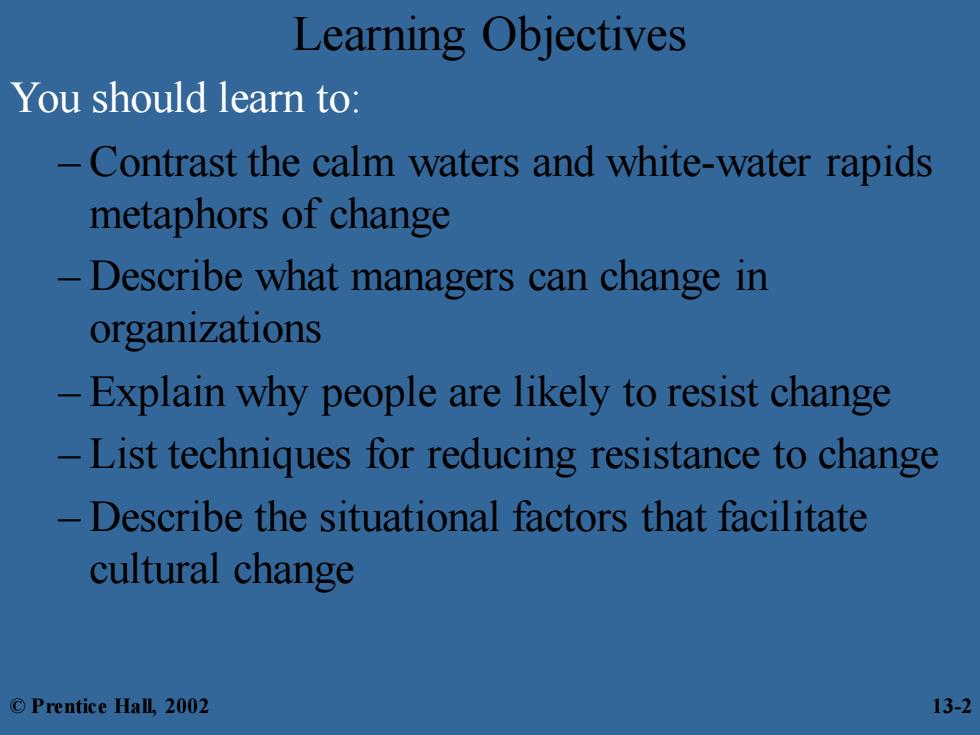
Learning Objectives You should learn to: -Contrast the calm waters and white-water rapids metaphors of change Describe what managers can change in organizations Explain why people are likely to resist change -List techniques for reducing resistance to change Describe the situational factors that facilitate cultural change ©Prentice Hall,2002 13-2
Learning Objectives You should learn to: – Contrast the calm waters and white-water rapids metaphors of change – Describe what managers can change in organizations – Explain why people are likely to resist change – List techniques for reducing resistance to change – Describe the situational factors that facilitate cultural change © Prentice Hall, 2002 13-2
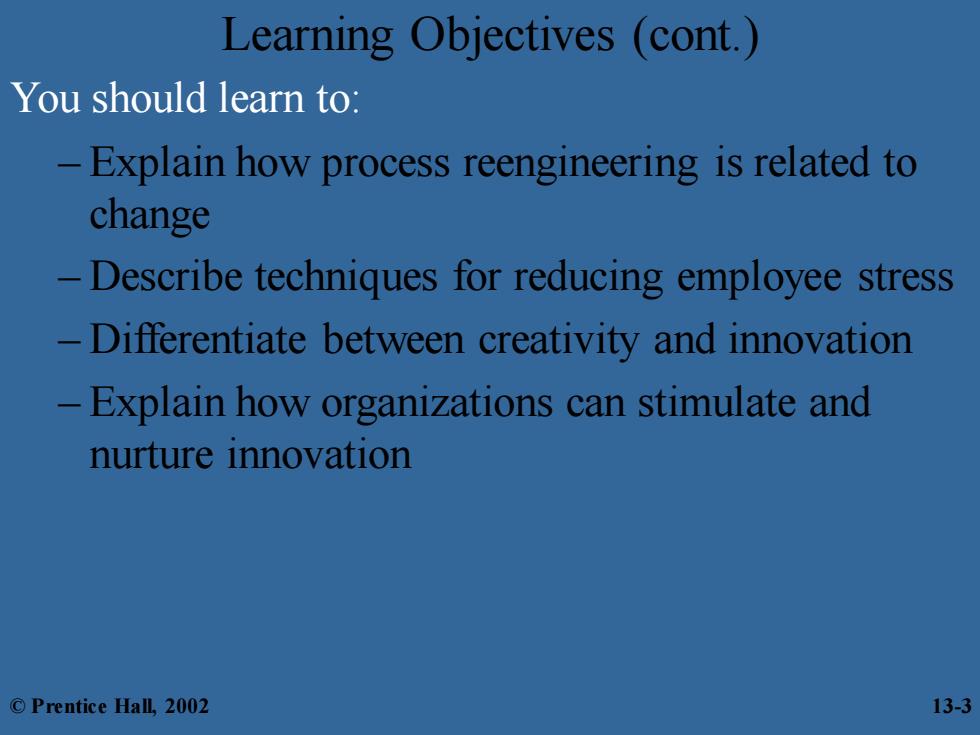
Learning Objectives (cont.) You should learn to: Explain how process reengineering is related to change Describe techniques for reducing employee stress Differentiate between creativity and innovation Explain how organizations can stimulate and nurture innovation ©Prentice Hall,.2002 13-3
Learning Objectives (cont.) You should learn to: – Explain how process reengineering is related to change – Describe techniques for reducing employee stress – Differentiate between creativity and innovation – Explain how organizations can stimulate and nurture innovation © Prentice Hall, 2002 13-3

What Is Change? Change -alterations in people,structure,or technology change is an organizational reality managing change is an integral part of every manager's job complicates the jobs of managers ©Prentice Hall,2002 13-4
What Is Change? Change – alterations in people, structure, or technology – change is an organizational reality – managing change is an integral part of every manager’s job • complicates the jobs of managers © Prentice Hall, 2002 13-4
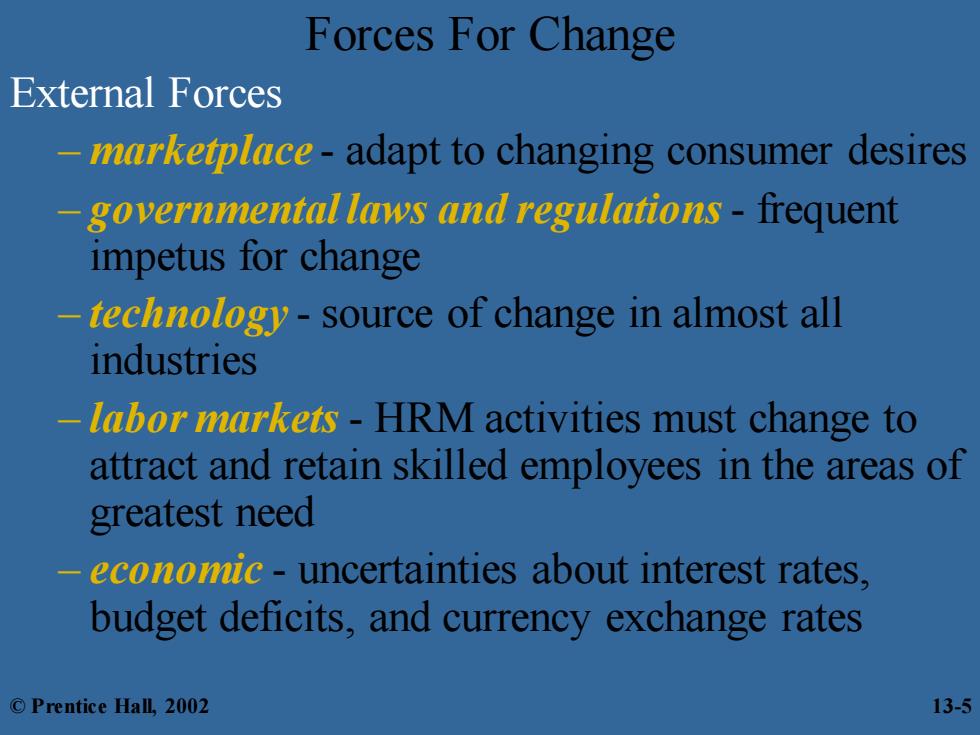
Forces For Change External Forces markeiollace-adapt to changing consumer desires governmental laws and regulations-frequent impetus for change -teclanollogy-source of change in almost all industries labor markeis HRM activities must change to attract and retain skilled employees in the areas of greatest need ecomomie-uncertainties about interest rates, budget deficits,and currency exchange rates ©Prentice Hall,2002 13-5
Forces For Change External Forces – marketplace - adapt to changing consumer desires – governmental laws and regulations - frequent impetus for change – technology - source of change in almost all industries – labor markets - HRM activities must change to attract and retain skilled employees in the areas of greatest need – economic - uncertainties about interest rates, budget deficits, and currency exchange rates © Prentice Hall, 2002 13-5
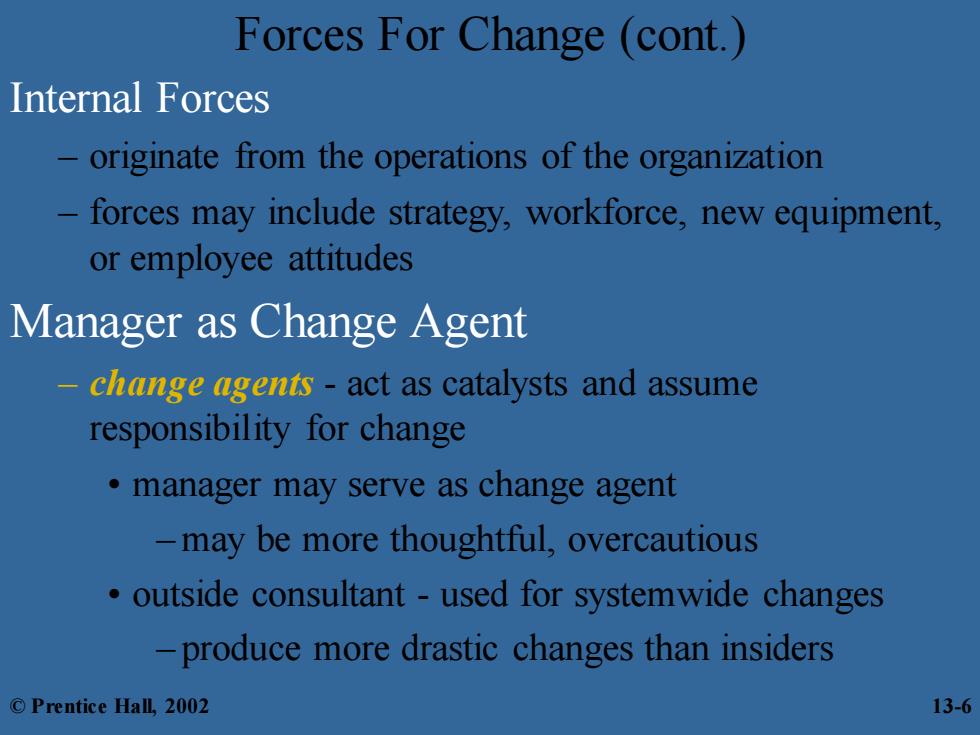
Forces For Change (cont. Internal Forces -originate from the operations of the organization forces may include strategy,workforce,new equipment. or employee attitudes Manager as Change Agent -change agenis-act as catalysts and assume responsibility for change manager may serve as change agent -may be more thoughtful,overcautious outside consultant-used for systemwide changes -produce more drastic changes than insiders ©Prentice Hall,2002 13-6
Forces For Change (cont.) Internal Forces – originate from the operations of the organization – forces may include strategy, workforce, new equipment, or employee attitudes Manager as Change Agent – change agents - act as catalysts and assume responsibility for change • manager may serve as change agent –may be more thoughtful, overcautious • outside consultant - used for systemwide changes – produce more drastic changes than insiders © Prentice Hall, 2002 13-6
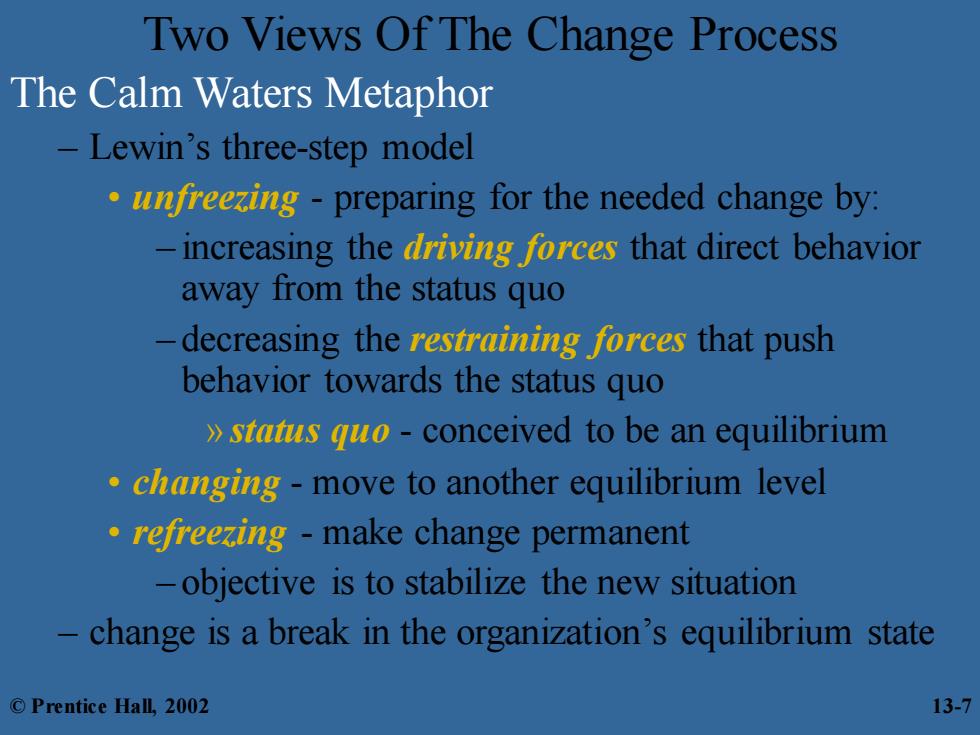
Two Views Of The Change Process The Calm Waters Metaphor Lewin's three-step model odfreezing-preparing for the needed change by -increasing the driving orces that direct behavior away from the status quo decreasing the restrining forces that push behavior towards the status quo >stains quto-conceived to be an equilibrium changing-move to another equilibrium level orefeezing -make change permanent -objective is to stabilize the new situation change is a break in the organization's equilibrium state ©Prentice Hall,2002 13-7
Two Views Of The Change Process The Calm Waters Metaphor – Lewin’s three-step model • unfreezing - preparing for the needed change by: – increasing the driving forces that direct behavior away from the status quo – decreasing the restraining forces that push behavior towards the status quo »status quo - conceived to be an equilibrium • changing - move to another equilibrium level • refreezing - make change permanent – objective is to stabilize the new situation – change is a break in the organization’s equilibrium state © Prentice Hall, 2002 13-7
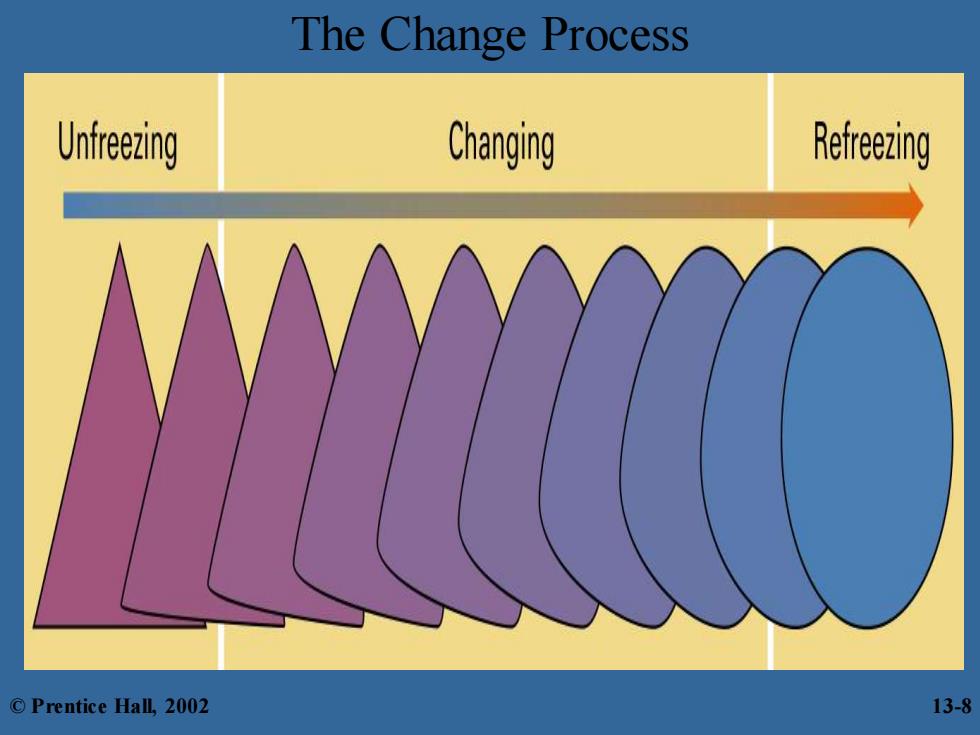
The Change Process Unfreezing Changing Refreezing ©Prentice Hall,2002 13-8
The Change Process © Prentice Hall, 2002 13-8
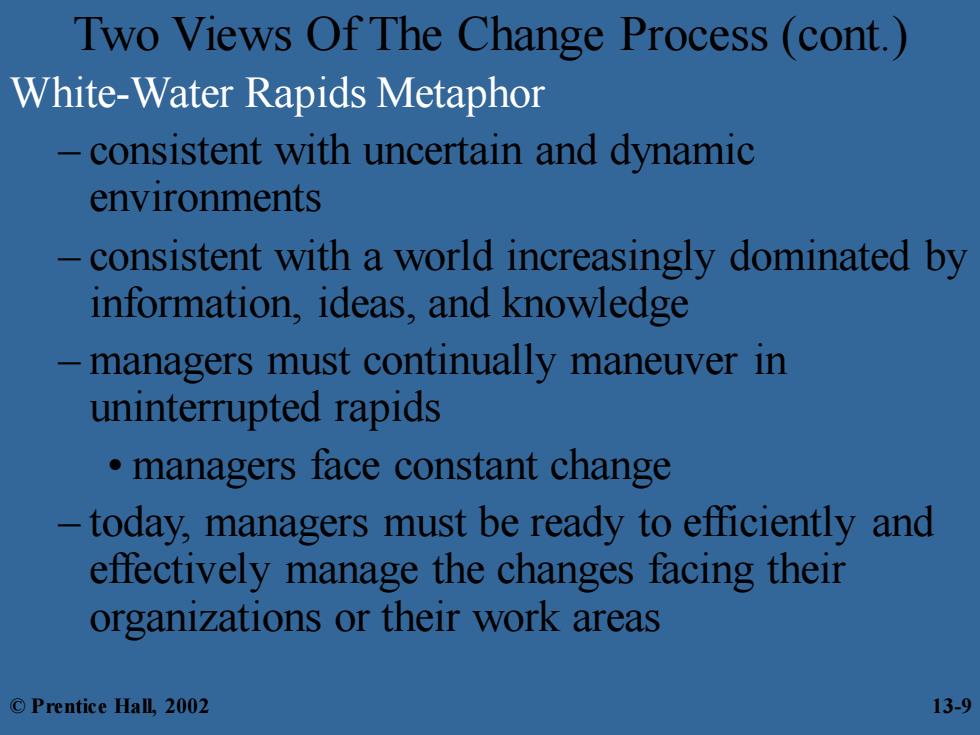
Two Views Of The Change Process (cont. White-Water Rapids Metaphor consistent with uncertain and dynamic environments consistent with a world increasingly dominated by information,ideas,and knowledge managers must continually maneuver in uninterrupted rapids managers face constant change today,managers must be ready to efficiently and effectively manage the changes facing their organizations or their work areas ©Prentice Hall,2002 13-9
Two Views Of The Change Process (cont.) White-Water Rapids Metaphor – consistent with uncertain and dynamic environments – consistent with a world increasingly dominated by information, ideas, and knowledge – managers must continually maneuver in uninterrupted rapids • managers face constant change – today, managers must be ready to efficiently and effectively manage the changes facing their organizations or their work areas © Prentice Hall, 2002 13-9
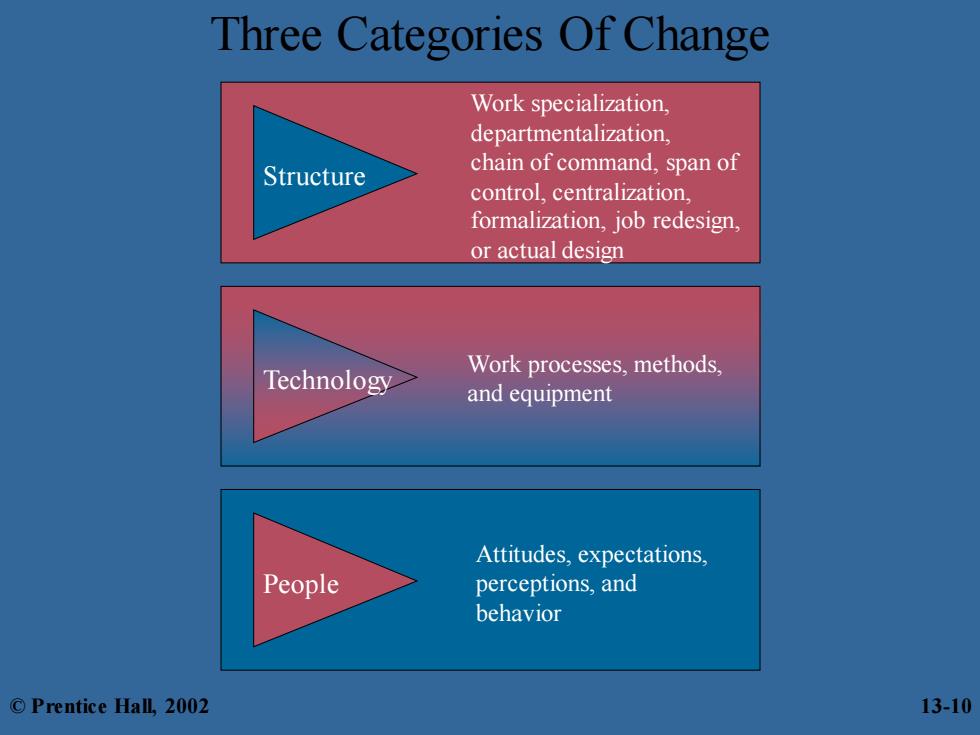
Three Categories Of Change Work specialization, departmentalization. Structure chain of command,span of control,centralization, formalization,job redesign, or actual design Technology Work processes,methods, and equipment Attitudes,expectations, People perceptions,and behavior ©Prentice Hall,2002 13-10
Three Categories Of Change Work specialization, departmentalization, chain of command, span of control, centralization, formalization, job redesign, or actual design Structure Attitudes, expectations, perceptions, and behavior People Work processes, methods, and equipment Technology © Prentice Hall, 2002 13-10